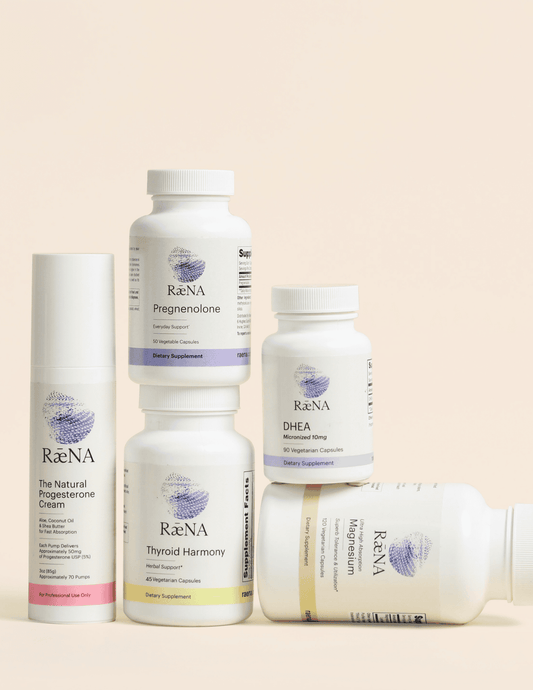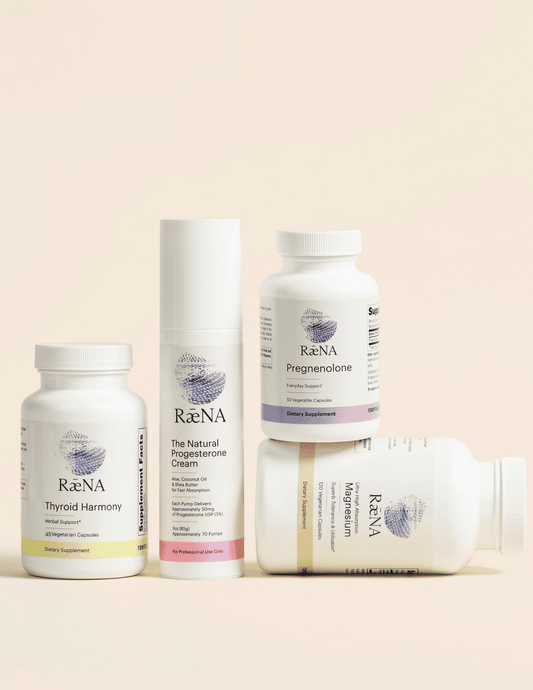
What Is Estrogen Dominance?
RaenaEstrogen Dominance Explained
Estrogen dominance is a condition where a person has deficient, normal, or excessive estrogen but little or no progesterone to balance its effects in the body.
Estrogen is crucial for day-to-day functioning. It regulates menstruation, hunger and satiety, and insulin sensitivity. It also helps metabolize cholesterol and contributes to bone density. However, sustained estrogen dominance may lead to a wide variety of medical problems caused by unopposed estrogen effects.
How is estrogen dominance determined?
Estrogen dominance is often measured by a woman’s progesterone to estrogen ratio (Pg/E2 ratio). When progesterone is low relative to estrogen, this ratio drops. This suggests relative progesterone deficiency. Even if estrogen levels are low, if progesterone drops faster, estrogen dominance can still occur. As long as progesterone is lower than estrogen, symptoms of estrogen dominance are likely.
Common symptoms of estrogen dominance
-
Headaches or migraines
-
Depression or anxiety
-
Memory problems
-
Allergies
-
PMS
-
Heavy or irregular periods
-
Breast tenderness
-
Hair loss
-
Cold hands and feet
-
Night sweats or hot flashes
-
Poor sleep
-
Fatigue
-
Bloating and digestive issues
-
Bacterial overgrowth
-
Skin rashes or acne
-
Excess cellulite or fat in hips
-
Fibroids, cysts, and other growths
-
Endometriosis
-
Low libido
-
Infertility
-
Gynecomastia
-
Water retention
-
Increased fat around hips and lower abdomen
-
Hypertension
-
Fibrocystic breasts
-
Endometrial and breast cancer
Causes of estrogen dominance
Estrogen dominance is increasingly common and linked to:
-
Obesity
-
Poor nutrition
-
Certain medications
-
Surgeries like hysterectomies
-
Low thyroid function
-
Sluggish liver function
-
Environmental toxins
Fat cells produce estrogen via the enzyme aromatase — so higher fat mass can increase estrogen levels. The liver helps clear estrogen during detoxification (Phase 1 & 2), but if overwhelmed (due to alcohol, lack of B vitamins, or toxin exposure), estrogen breakdown is impaired, leading to re-circulation and excess estrogen.
Exposure to xenoestrogens (toxic compounds that mimic estrogen) and poor liver function also contribute to estrogen dominance, causing symptoms like skin inflammation and acne.
Estrogen dominance in menopause?
Contrary to common belief, estrogen does not drop to zero after menopause. While ovarian estrogen production declines, estrogen continues to be produced by fat and skin cells, often leading to elevated levels, especially of estrone — an estrogen form linked to breast cancer risk. Menopause simply means ovarian estrogen is no longer enough to trigger menstrual cycles.
Why is estrogen dominance important?
Estrogen can promote the growth of certain cancers, including breast cancer. Knowing your estrogen levels is essential — estrogen is not inherently “bad,” but excessive unopposed estrogen causes problems.
How to check estrogen dominance?
Blood tests measuring both estrogen and progesterone levels are necessary. At-home testing kits like those from Raena can help you track your levels. Ideally, progesterone should be 5 to 10 times higher than estrogen to balance its effects.
How to improve estrogen dominance?
-
Increase progesterone naturally or through supplementation
-
Support healthy thyroid function
-
Reduce stress
-
Support metabolism with a nutrient-rich diet
-
Ensure adequate protein and B vitamins to support liver detox
-
Include vitamins A and E which help protect tissues against estrogen’s harmful effects and boost progesterone
Check your estrogen levels today at www.raena.com
MEDICAL DISCLAIMER: All information provided by Raena on this website or any other format is for informational purposes only and is not a substitute for professional medical advice, diagnosis, or treatment. Always consult your personal physician or qualified health provider with any medical questions. Never replace professional medical advice or delay seeking it because of information read here. This information is not meant to diagnose, treat, or cure any medical condition.


